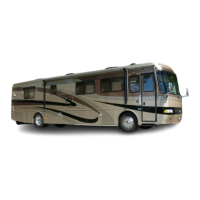Care & Maintenance
----------------------------------------------------------------------------------------------------------------------------------------------------------------------------------------------------------------------------------------------------------------------------------------------------------------------------------
WINDSOR3•88
• The holding tanks should be drained and fresh water system winterized with
potable antifreeze or winterize the plumbing system using air pressure.
• Retract and secure all awnings.
• Turn the battery cut-off switch OFF.
• If applicable, disable auto-genstart feature.
• Batteries should be stored fully charged. Batteries stored in a dis-
charged state will readily freeze.
• If possible, park the motorhome leaving the batteries accessible. A bat-
tery may be charged or changed without moving the motorhome.
• If available, leave the motorhome hooked to shore power. Leave the
main battery disconnect switches ON.
• Careful placement of a small heat source in the interior will help control
moisture. Desiccate filter systems will help remove interior moisture.
• If AC power is not available turn main battery disconnect switches OFF.
• If possible, store the motorhome inside a storage building.
• If stored outside, inspect all seams and seals for possible leakage.
• Store the motorhome with a full fuel tank to help against moisture con-
densing at top of fuel tank.
• Vents and windows should be closed to prevent wind driven rain
entrance.
• Tires should be stored at maximum inflation pressure.
• A full interior inspection for water leaks should be made bi-monthly,
inspecting behind all cabinet doors and drawers.
Long term storage of the motorhome can be defined as leaving a motorhome
unattended for a period of thirty days or more. A motorhome requires protection
from the elements just as a house or a car would. When left out in the environment
without proper storage or maintenance, a motorhome, house or car is vulnerable to
the moisture and oxidation processes inherent in the environment.
There are preventative measures which should be taken and preferable situations
to use when storing a motorhome. Such measures will aid in protecting and prevent-
ing a motorhome from the damaging effects caused by an accumulation of moisture.
NOTE: The natural process of moisture in the air condensing will
occur with temperature changes of 30º Fahrenheit or more in one
day. Humidity readings of 60% or greater will allow the accumu-
lated moisture to remain for extended periods of time
.
If the motorhome is stored in a location where AC power is not available:
• Turn off all appliances.
• If possible, situate the motorhome so the batteries remain
accessible. This allows a battery to be charged or replaced
without moving the motorhome.
• Charge the batteries to a full state of charge.
• Turn the main battery disconnects to OFF.
STORAGE
- Long Term

